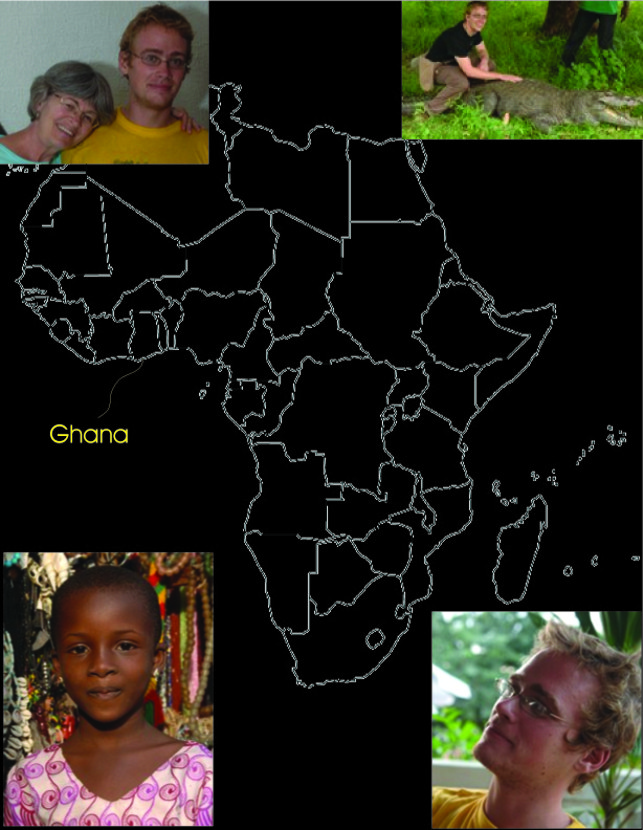 |
The highlight of our 2006 travels,
and perhaps the last twenty years, was our three week trip to Africa to
visit with our son Jon, who is serving in the Peace Corps in Ghana.
Ghana is situated
on the southern coast of the West African bulge and is bordered to the east
by Togo, to the west by the Ivory Coast, to the south by the Atlantic Ocean
and to the north and northwest by Burkina Fasso.
The coastline consists mostly of a low sandy, foreshore behind which
stretches the coastal plain, except in the west where the forest comes down
to the sea. The forest belt, which extends northward from the western coast
and then eastward into Ashanti for about 170 miles, is broken up into
heavily wooded hills and steep ridges. North of the forest is undulating
savanna drained by the Black Volta and White Volta rivers, which join and
flow south to the sea through a narrow gap in the hills. Ghana's highest
point is 2,9000 feet in a range of hills on the eastern border. Apart from
the Volta, only the Pra and the Ankobra rivers permanently pierce the sand
dunes, most of the other rivers terminate in brackish lagoons. There are no
natural harbors.
The climate is tropical but relatively
mild for the latitude. Climatic differences between various parts of the
country are affected by the sun's journey north or south of the equator and
the corresponding position of the intertropical convergence zone, the
boundary between the moist southwesterly winds and the dry northeasterly
winds. Except in the north, there are two rainy seasons, from April to June
and from September to November. In the north squalls occur in March and
April, followed by occasional rain until August and September, when the
rainfall reaches its peak.
Temperatures range between 70°F - 90°F (21°C and 32°C), relative humidity
between 50% and 80%. Rainfall ranges from 30 to 80 inches a year. The
harmattan, a dry desert wind, blows from the northeast from December to
March lowering the humidity and causing hot day and cool nights in the
north. The effect of this wind is felt in the south during January. In most
areas, temperatures are highest in March and lowest in August after the
rains. Variation between day and night temperatures is relatively small, but
greater in the north, especially in January.
Ghanians come from six main ethnic groups: the Akan (Ashanti and Fanti), the
Ewe, the Ga-Adangbe, the Mole-Dagbani, the Guan, and the Gurma.
Ashanti Tribe
The Ashanti tribe of the Akan are the largest tribe in Ghana and one of the
few matrilineal societies in West Africa. Once renown for the splendour and
wealth of their rulers, they are most famous today for their craft work,
particularly their hand-carved stools and fertility dolls and their colorful
kente cloth. Kente cloth is woven in bright, narrow strips with complex
patterns; it's usually made from cotton and is always woven outdoors,
exclusively by men.
The village is a social as well as an economic unit. Everyone participates
in the major ceremonies, the most frequent of which are funeral celebrations
which typically last several days. Attendance at funerals is normally
expected from everyone in the village and expenditure on funerals is a
substantial part of the household budget.
The Ashanti are noted for their expertise in a variety of specialized
crafts. These include weaving, wood carving, ceramics, and metallurgy. Of
these crafts, only pottery-making is primarily a female activity; the others
are restricted to male specialists. Even in the case of pottery-making, only
men are allowed to fashion pots or pipes representing anthropomorphic or
zoomorphic figures. |







